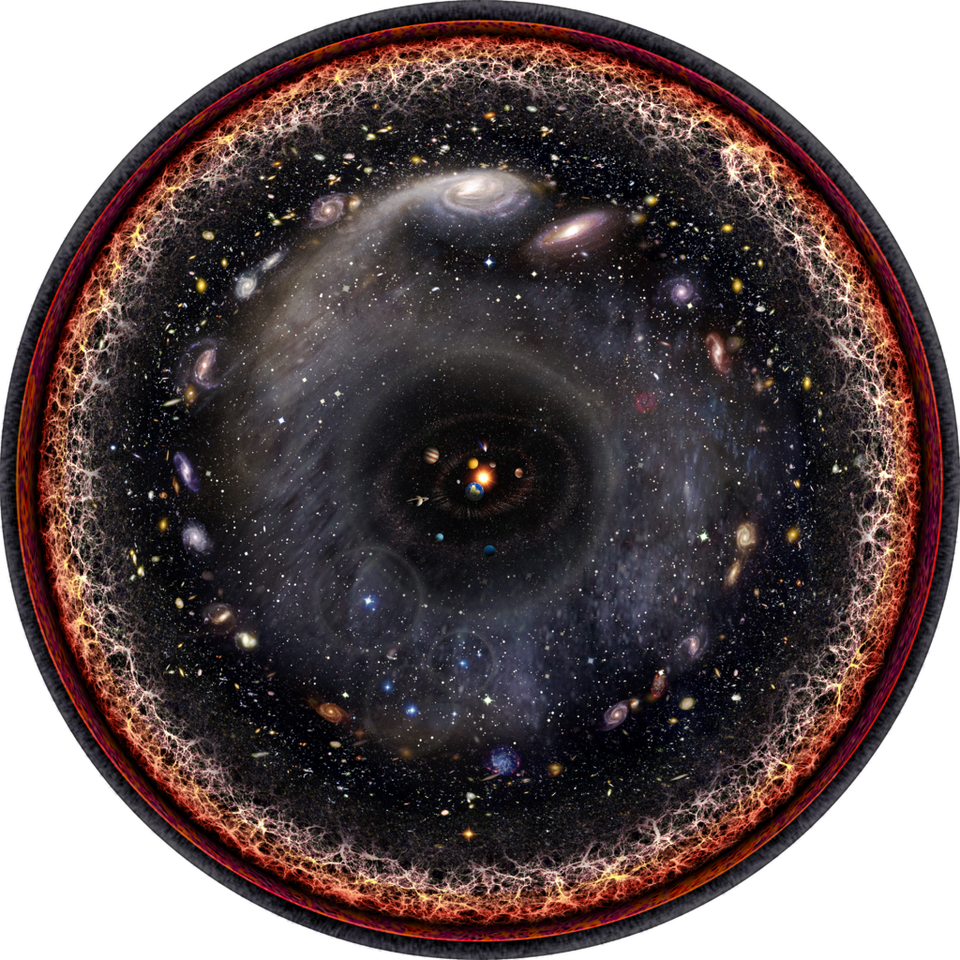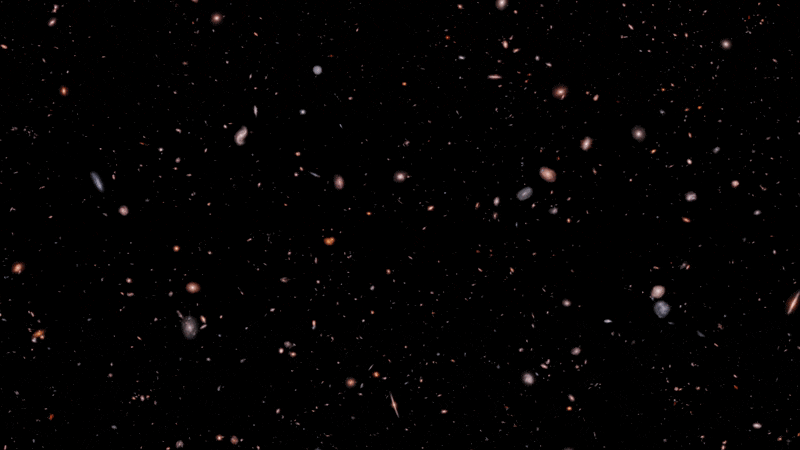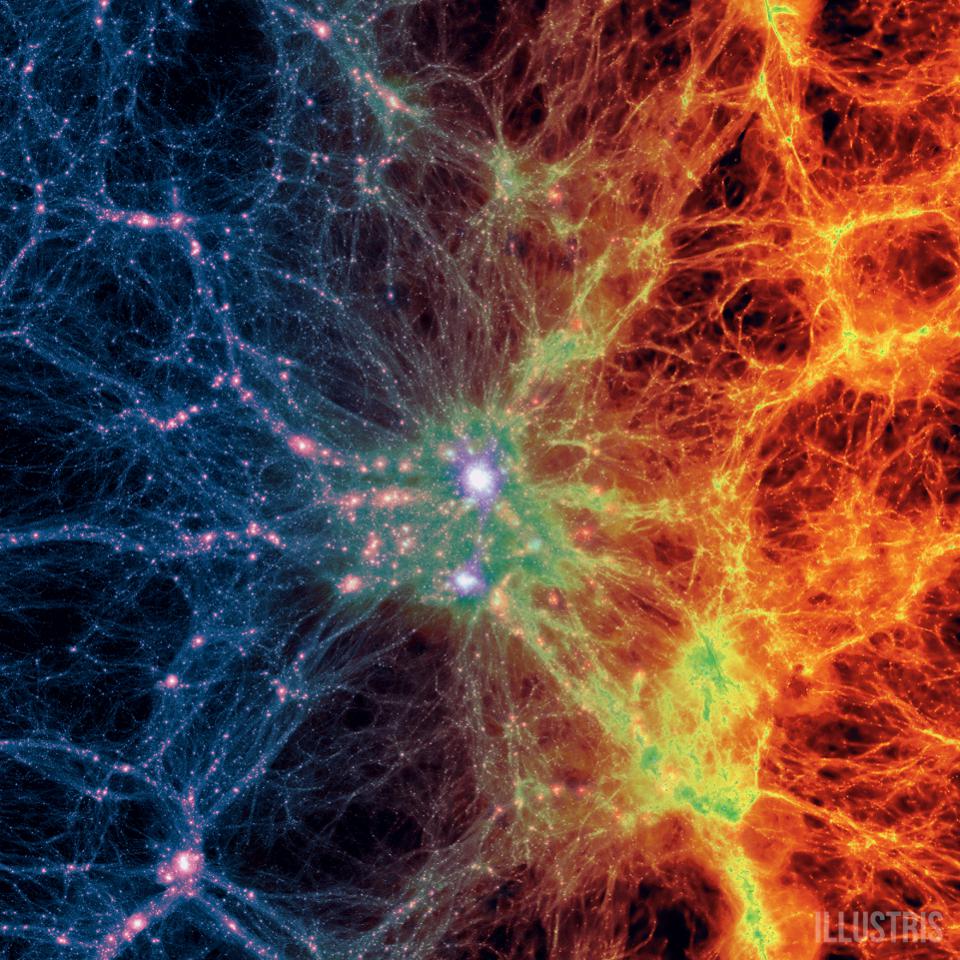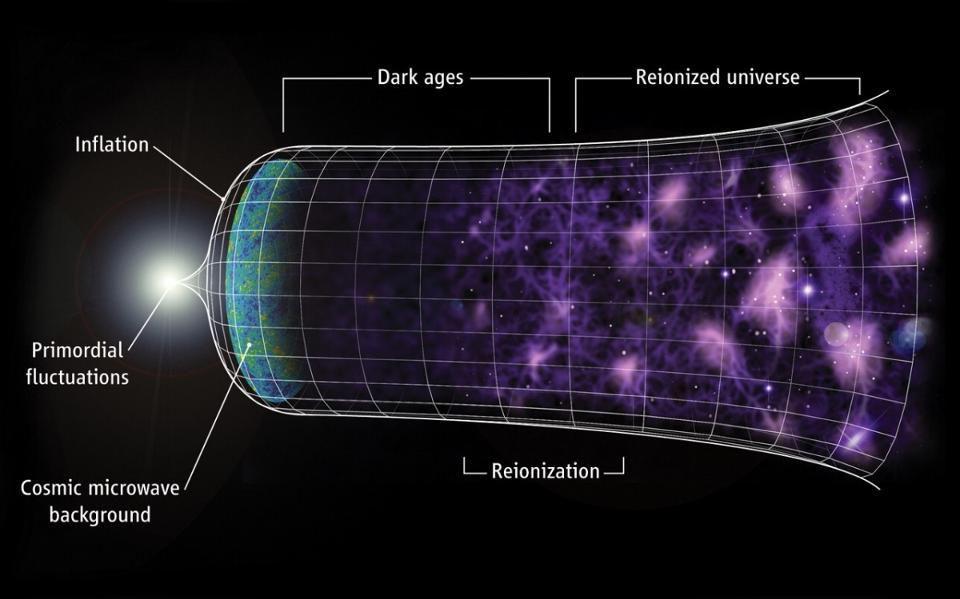Where is the true center of the Universe?

- If you were to measure the recession speed and distance of every galaxy in the Universe, you could trace everything back to a single point, and find, perhaps surprisingly, that point isn't centered on us.
- However, that point, several millions of light-years away, doesn't hold any special significance at all, and can't rightly be regarded as the center of the Universe in any meaningful way.
- That's because what we conventionally think of as the Big Bang didn't occur at a single point in space, but rather long ago and everywhere at once: at a moment in time. Here's how to properly think about the "center" of the Universe.
No matter which direction we look in, or how far away our telescopes and instruments are capable of seeing, the Universe appears pretty much the same on large cosmic scales. The number of galaxies, the types of galaxies that are present, the populations of stars that exist within them, the densities of normal matter and dark matter, and even the temperature of the radiation that we see are all uniform: independent of the direction we look in. On the grandest cosmic scales of all, on scales of several billions of cubic light-years, the average difference between any two regions is merely 0.003%: about 1-part-in-30,000.
The biggest differences that we see, in fact, aren’t a function of which direction we look in, but rather how far away we’re looking. The farther away we look, the farther back in time we’re viewing the Universe, and the greater the amount the light from those distant objects is shifted toward longer wavelengths. A lot of people, upon hearing this, get a particular picture in their heads: the greater the amount the light is shifted, the faster these objects are moving away from us. Therefore, if you look in all directions and reconstruct, “At what point, in space, would we see all directions receding equally?” you could locate the center of the Universe.
And we can perform that exercise if we like, but “the center of the Universe” isn’t what we arrive at. Here’s what’s really going on with our best scientific knowledge concerning the center of the Universe.
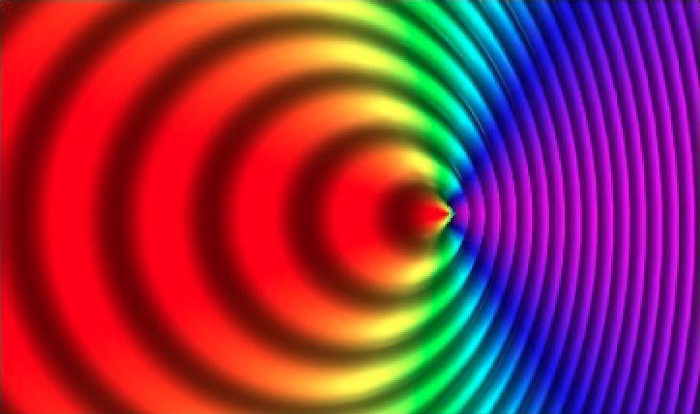
Most of us understand, intuitively, that when objects move toward you, the waves they emit appear compressed, with their crests and troughs closer together. Similarly, when they move away from you, the waves appear the opposite of compressed — rarified — with their crests and troughs farther apart than if they were stationary. Although we typically experience this with sounds, as you can tell whether a fire truck, a police car, or the ice cream cart is moving toward you or away from you dependent on its pitch, it’s true for any wave, including light. We refer to this motion-based shift of the waves as the Doppler effect, named after its discoverer.
Only, when it comes to light, a change in the wavelength doesn’t correspond to higher or lower pitches, but higher or lower energies. For light:
- longer wavelengths mean lower frequencies, lower energies, and redder colors,
- while shorter wavelengths mean higher frequencies, higher energies, and bluer colors.
For any individual object that we measure, because of the nature of matter in the Universe, there will be atoms and ions present that we recognize. All atoms and ions emit and/or absorb light only at particular wavelengths; if we can identify which atoms are present and we can measure a systematic shift to these spectral lines, we can calculate just how redshifted or blueshifted the light actually is.

What we find, when we do this, is something quite remarkable. For the closest objects, we see both redshifts and blueshifts, corresponding to speeds ranging from a few hundred to a few thousand kilometers-per-second. Galaxies like the Milky Way, which aren’t tightly bound to large, massive groups or clusters of galaxies, typically top out with lower speeds, while galaxies near the center of large, massive clusters can achieve speeds as high as ~1-2% the speed of light.
As we look farther away, to objects at greater distances, we still see that same range — the inferred speeds among the galaxies we see vary from hundreds to thousands of km/s — but everything is shifted to redder colors dependent upon their distance from us.
The observations are very clear: the farther an object is from us, on average, the greater the observed redshift is. But is that because the object is actually moving through space, relative to us, when it emits the light versus when we absorb and measure the light? Or is it because there’s an overall expansion happening on cosmic scales, causing the light to continue to shift during its long journey across the space that separates us from what we’re trying to observe?

While the first scenario is easy to understand — objects exist in space and move through it — the second one requires a little bit of explanation. In Einstein’s general relativity, space isn’t simply a static “background” that particles and other objects move through, but rather it’s part of a fabric, along with time, that evolves dependent on the matter and energy present within it. A large mass in one particular location will cause that fabric to curve around that location, compelling every quantum in that space to travel not in a straight line, but rather along a path determined by the curvature of space. The bending of starlight around the Sun during a total solar eclipse, for example, was the first definitive test that showed gravity obeys Einstein’s predictions, in conflict with those of Newton’s older theory of universal gravitation.
Another thing that general relativity dictates is that if you have a Universe that’s uniformly filled with matter and/or energy, that Universe cannot maintain a spacetime that’s static and unchanging. All such solutions are immediately unstable, and your Universe must either expand or contract. As this spacetime evolves, the light within it also evolves:
- with its wavelength shrinking as the fabric of space contracts,
- or with its wavelength lengthening as the fabric of space expands.
As light travels through the Universe, the effects of the evolution of space gets imprinted on the very properties of the light that will eventually arrive at our eyes.

In principle, both of these effects are occurring. The fabric of space itself is evolving, causing the light traveling within it to systematically shift, and the galaxies and other light-emitting objects within the Universe are also moving through that evolving space, leading to motion-dependent shifts.
There is no way to know, from first principles, which one would cause the primary effect that our Universe would be experiencing. Mathematically, you can have multiple solutions to the same equation, and the equations of general relativity are no exception to that rule. The Universe — observed to be full of “stuff” — could have been either expanding or contracting. Superimposed atop that cosmological shift, we’d expect to find what we call peculiar velocities, or how the stuff within that Universe moves due to effects like the gravitational forces of all the other sources of matter and energy in the Universe.
Whatever shift we observe for a particular, single object will be a combination of all of these effects together. Whenever we simply measure how the light from one object is shifted, we cannot know which component is cosmological and which component is non-cosmological. But by observing a great many objects at a great many distances, we can find, from the overall, average trends, how the Universe is evolving as a whole.

As first noted way back in the late 1920s, the evidence not only overwhelmingly points to a Universe that’s expanding, but the predicted way that the Universe is expanding spectacularly agrees with the predictions of general relativity for a uniformly-filled Universe with various types of matter and energy. Once you know what your Universe is made out of and how it’s expanding today, general relativity’s equations are completely predictive: we can figure out what the Universe was like, in terms of size, separation distance, and its instantaneous expansion rate, at every point in its past, and what it will be like at every point in our future.
If this is what’s going on, however, then the expanding Universe isn’t like an explosion at all, which had a point-of-origin that everything — like shrapnel — flies outward at varying speeds. Instead, the expanding Universe is more like a leavening loaf of dough with raisins throughout it. If you’re a gravitationally bound object, like a galaxy, you’re one of the raisins, while space itself is the dough. As the dough leavens, the individual raisins appear to be moving apart relative to one another, but the raisins themselves aren’t moving “through” the dough. Each raisin sees itself as relatively stationary, but each other raisin that it sees will appear to move away from it, with the more distant raisins appearing to move away more quickly.

So how do we know how big this “ball of dough” is, where we are located within it, and where its center is?
This would only be an answerable question if we could see beyond the edge of the “dough,” which we cannot. In fact, to the extreme limits of the part of the Universe that we can observe, the Universe is still perfectly uniform to within that same 1-part-in-30,000, everywhere. Our Big Bang, which occurred 13.8 billion years ago, means that we can see out to a maximum of about ~46 billion light-years in all directions, and even at that distant limit, it’s still remarkably uniform. This places no constraints on:
- how large the “ball of dough” that represents our Universe can be,
- how large the unobservable Universe beyond our visibility limit is,
- what the topology and connectedness of the unobservable Universe is,
- and what the allowable “shapes” for the limits of our Universe are,
where the last includes the sub-questions of whether our Universe even has a center (or not), whether it’s finite (or not), and what our location is with respect to any larger structure the Universe may have. All we can conclude is that the Universe appears perfectly consistent with general relativity, and that, just like any individual raisin within the dough that couldn’t see beyond the edge of the dough itself, any observer could lay equal claim to the obvious (but incorrect) conclusion you’d draw if you saw everything moving away from you, “I’m at, or very near to, the actual, exact center.”

Only, it’s not correct to say we’re at “the center” at all. The only thing that’s privileged about our location in space is that the objects we see nearby are the oldest, most evolved objects we can see today, with the more distant objects being younger. The expansion rate nearby is lower, at present, than the expansion rate we see at greater distances. And the light from the closest objects is less redshifted, and their shifts are less dominated by the cosmological component of redshift, than the more distant objects.
That’s because the objects that exist all throughout the Universe can send no signals that travel faster than light, and that the light we’re observing from them, today, corresponds to the light that’s arriving right now, but must have been emitted some time ago. When we look back through space, we’re also looking back through time, seeing objects:
- as they were in the past,
- when they were younger and closer (in time) to the Big Bang,
- when the Universe was hotter, denser, and expanding more rapidly,
- and, in order for that light to arrive at our eyes, it had to get stretched to longer wavelengths over the entirety of its journey.
There is, however, one thing we can look at if we wanted to know where, from our perspective, all directions truly appeared as perfectly uniform as possible: the cosmic microwave background, which itself is the leftover radiation from the Big Bang.

At all locations in space, we see a uniform bath of radiation at precisely 2.7255 K. There are variations in that temperature depending on which direction we look on the order of a few tens to perhaps a few hundred microkelvin: corresponding to those 1-part-in-30,000 imperfections. But we also see that one direction looks a little bit hotter than the opposite direction: what we observe as a dipole in the cosmic microwave background radiation.
What could cause this dipole, which is actually quite large: about ±3.4 millikelvin, or about 1-part-in-800?
The simplest explanation is, going all the way back to the beginning of our discussion, our actual motion through the Universe. There actually is a rest frame to the Universe, if you’re willing to consider, “At this location, I must be moving at this particular speed so that the background of radiation I see is actually uniform.” We’re close to the right speed for our location, but we’re a little bit off: this dipole anisotropy corresponds to a speed, or a peculiar velocity, of about 368 ± 2 km/s. If we either “boosted” ourselves by that precise speed, or kept our current motion but moved our position to be about 17 million light-years away, we’d actually appear to be at a point that was indistinguishable from a naive definition of the Universe’s center: at rest with respect to the overall, observed cosmological expansion.

That’s remarkably close by! After all, we can see for some ~46.1 billion light-years in all directions, and 17 million light years is only 0.037% of the radius-of-the-Universe away from us. But the more sober truth is not that we’re near the center, but that any observer in any galaxy would conclude that they were at (or very near) the center as well. No matter where in the Universe you’re located, you’ll find yourself existing at this particular moment in time: a certain, finite amount of time after the Big Bang. Everything that you see appears as it was when the light from it was emitted, with the arriving light being shifted by both the relative motions of what you’re observing with respect to you and also the expansion of the Universe.
Depending on where you lived, you might see a dipole in your cosmic microwave background corresponding to a motion of hundreds or even thousands of km/s in a particular direction, but once you accounted for that piece of the puzzle, you’d have a Universe that looked just like it does from our perspective: uniform, on the largest scales, in all directions.
The Universe is centered on us in the sense that the amount of time that’s passed since the Big Bang, and the distances that we can observe out to, are finite. The part of the Universe we can access is likely only a small component of what actually exists out there. The Universe could be large, it could loop back on itself, or it could be infinite; we do not know. What we are certain of is that the Universe is expanding, the radiation traveling through it is getting stretched to longer wavelengths, it’s getting less dense, and that more distant objects appear as they were in the past. It’s a profound question to ask where the center of the Universe is, but the actual answer — that there is no center — is perhaps the most profound conclusion of all.
